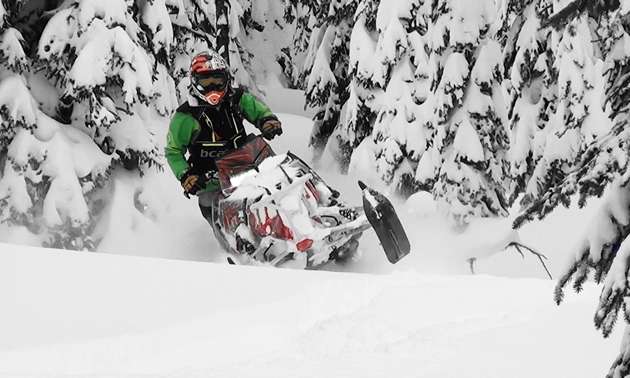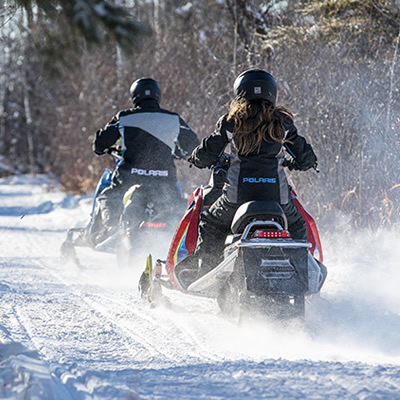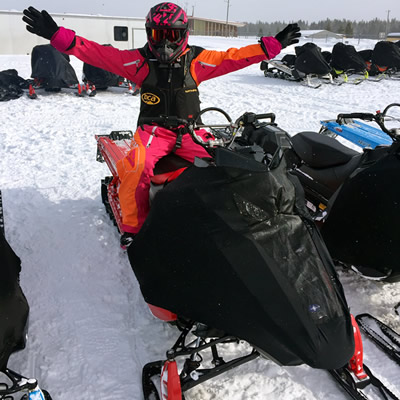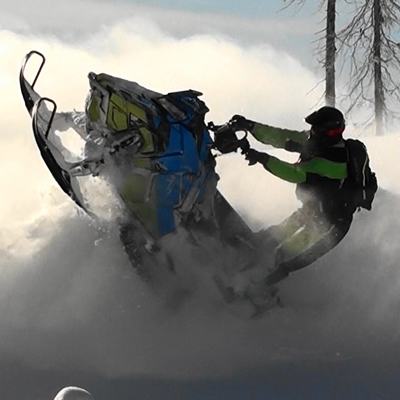Thinking back to my introduction to mountain snowmobiling gives me a bit of anxiety. What did I know about mountain riding? Born and raised in Alberta, it was only in 2001 that I came to live in Creston, B.C. My frame of reference for snowmobiling consisted of cruising the hayfields and powerlines in southwestern Alberta. Transceivers and probes were quite foreign to me, but shovels—well, shovels were made for digging out snowmobiles, right?
Not even close. It was only when a good friend sat me down and had a heart-to-heart talk with me about the dangers of avalanches and winter survival that I started the journey into the right way to mountain ride.
Mistakes, I’ve made more than a few, I suppose that is why I’m writing about mountain riding and backcountry preparedness. How naive I was! With my shovel and pack strapped to my sled (some of my friends suggested I put my shovel underneath my hood), I became a “sledder.” Not even close. I was simply someone who was riding a snowmobile.
Everyone starts from somewhere
Then:
I don’t ride in avalanche terrain was my mindset. I’m on logging roads and cutblocks for crying out loud. How could there possibly be any danger?
Now:
I realize that if it can slide one day, it will. This includes logging roads, cutblocks and areas that have never in history slid. I take nothing for granted and I am acutely aware of the terrain we ride in.
Then:
I had no idea what a transceiver, shovel or probe were for. Beacon—what is that? Something that sends out a signal like the Batman sign to let people know I need help? Probe? Sounds painful.
Now:
I ride with a transceiver, shovel and probe, and an avalanche airbag. I routinely practise and hold transceiver search practices throughout the year for our snowmobile club and other visitors to our area. I not only have my safety equipment, I know how to use it.
Then:
Avalanche airbags are way too expensive for me to afford. Not having one will force me to ride more carefully.
Now:
Both my husband and I have purchased avalanche airbags. What is your life worth to you? Is $1,000 worth your life? To me, it’s a minute expense to have one more tool to help save my life if we were involved in an avalanche. I am choosing to go out in the backcountry and aggressively mountain ride so I need to make sure I’m taking every precaution possible to ensure I come home at night. “She died doing what she loved,” is absolutely no comfort to my children if I were to die out snowmobiling. I know this for certain. We’ve talked about it and my kids understand how important safety is. Each of my four children are skilled at transceiver searching, and understand the importance of backcountry safety and preparedness.
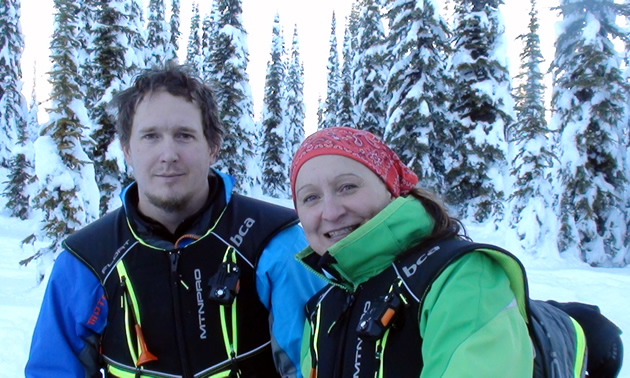
Then:
I wouldn’t think twice about going off by myself on my snowmobile. Access to the mountains was right out of my doorstep, and sometimes there wasn’t anyone to ride with so I’d go by myself.
Now:
I have a huge respect for the winter backcountry and will not ever go riding alone. Too much could go wrong, including equipment failure, a colossal stuck or a basic tipover into a tree well that could turn into a life-threatening situation. Going out alone is not an option.
Then:
Avalanche awareness classes were all I had under my belt.
Now:
Realizing that the free avalanche awareness workshops available are no substitute for AST training I have my AST 1 under my belt and am working towards furthering my avalanche education. I organize and host avalanche classes in my area, and speak to the masses about the importance of avalanche skills training.
Then:
Protective equipment, to me, was a helmet and goggles.
Now:
After some pretty crazy wrecks, which included broken ribs, a bruised bladder and kneecaps, and a shredded shin, I have upgraded my protection to include a chest protector and knee/shin pads, along with extra gloves and awesome gear to keep me dry and warm. Your outerwear is a form of protection so be choosy when it comes to your jacket, bibs/pants and boots. Hypothermia and frostbite are a reality should you become delayed or stranded in the winter backcountry.
Then:
I would go riding with “the gang.” Not understanding that my life was in their hands, the group consistently had individuals who didn’t have the equipment or the understanding of backcountry safety.
Now:
I’m very particular about who I ride with. I love my life and understand that my life is in the hands of those I ride with. These riders understand how to navigate terrain safely and they know the basics, such as understanding there should be only one rider on the hill at a time and that you need to be willing to change plans mid-ride to suit the conditions. These riders—I trust them and they trust me.
Then:
Because I was so new to the sport, I’d keep my mouth shut, not saying a peep when I felt a situation was reckless or unsafe. I didn’t want to appear uncool or stupid, so I kept my mouth shut. What if I said something stupid and they didn't let me come riding anymore?
Now:
I speak up wholeheartedly when I feel a situation is unsafe. Even if we come upon another group that is demonstrating unsafe practices, I’ll speak up. I am not daunted by someone calling me a killjoy, the fun police or worse. Lives matter! All lives matter.
Then:
I believed that because people had been riding for a long time—decades even—they must be the epitome of wisdom. They would help keep me safe.
Now:
I realize that the number of years snowmobiling have absolutely no correlation to wisdom in the backcountry. Sometimes, the ones who have been riding the longest are those who are the most unsafe. Lack of current equipment, especially transceivers, and an over-familiarity with the terrain causing complacent decision making are just a couple of the stumbling blocks that these seasoned riders can demonstrate.
Then:
I ignored that intuitive ”spidey sense” I would sometimes get out in the backcountry.
Now:
I absolutely listen to my intuition and voice concerns when needed. Sometimes, it means skipping a ride—like a promotional ride I opted out of, even though it was an all-expense paid trip to an awesome destination! A Special Public Avalanche Warning (SPAW) had been issued, and conditions were dangerous, even in the trees. I skipped the ride, but later found out a gentleman I was to be riding with that day had died in an avalanche. An area that really didn’t appear dangerous historically took the life of a rider. Listen to your intuition, and be open about what you’re feeling. Chances are, others in your group are having the same spidey senses tingling within them as well.
Then:
I had never known anyone who'd been in an avalanche. I was clearly of the “it can’t happen to me” mindset.
Now:
I have lost three friends to avalanches, and have been present when a close riding friend triggered a slide. It could have been me—it almost was me as I chose to drop the chute second, not first like I had originally wanted. I wanted the fresh snow to slow me down. I know that if I don’t use my brain as my number 1 most important tool, it will happen to me.
You see many people on social media become defensive when confronted with their lack of safety and concern. “Those holier-than-thou-people who won’t ride with me because I don’t have a transceiver” is quite a common remark.
Take it from me. It is not because we think we are holier than thou or better than you, it is because we learned the hard way why we cannot take safety for granted. We have learned by our mistakes, and we genuinely do not want people to have to learn that way. Learn from the mistakes of others, and set your ego aside. No one is picking on you, but snowmobilers have to step up their game.
Snowmobilers everywhere need to ride with the appropriate safety equipment and training and they must choose to use their heads. Survival equipment is only as good as the individual using it.
Humbly yours,
Trish (a.k.a Sledmomma)
